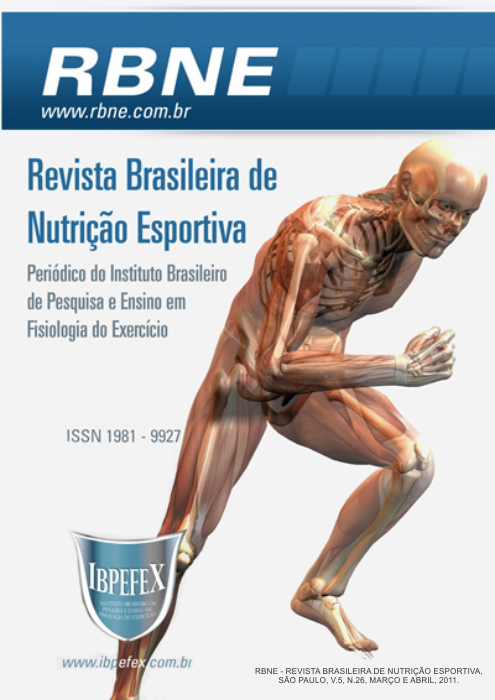Modulation of plasma osmolality after indoor exercise
Abstract
Objective: The objective of this study was to evaluate changes in plasma osmolality after the practice of indoor cycling. Materials and Methods: The study included 11 volunteers, male, aged between 18 and 30 years, not practitioners of indoor cycling, apt to performing physical exercise. The volunteers were submited to practice indoor cycling, during 60 minutes and with intensity between 65 and 80% of maximum heart rate. Results: The results suggest that 60 minutes of exercise performed in the intensity between 65 and 80% of maximum heart rate is not sufficient to bring about significant changes in plasma osmolality. Discussion: The assessment of plasma osmolality despite being the most reliable method to assess hydration levels, appears to be the best method to assess acute changes in hydration levels and, therefore, it is believed that the changes in mass represent the body more effectively and efficiently in this case. Conclusion: We conclude with this study that the practice of indoor cycling with volume and intensity for 60 minutes between 65 and 80% of maximum heart rate , does not significantly alter plasma osmolality.
References
-Bergeron, M. F. Sodium: the Forgotten Nutrient. Sports Science Exchange. Vol. 13, Núm. 3, 2000.
-Brouns, F. Fundamentos de Nutrição para os Desportos. 2ª edição. Rio de Janeiro, Guanabara Koogan, 2005.
-Casa, D. J.; Armstrong, L. E.; Montains, S. J.; e colaboradores National Athletic Trainer Association Position Statement: Fluid Replacement for Athletes. Journal of Athletic Training, Vol. 35, Núm. 2, 2000.
-Cheuvront, S. N. Avaliação da Hidratação de Atletas. Sports Science Exchange. Vol. 18, Núm. 2, 2006.
-Lamb, F. R.; Sherata, A. H. Benefits and Limitations to Pre-hydraties. Sports Science Exchange. Vol. 12, Núm. 2, 1999.
-Machado-Moreira, C. A.; Vimieiro-Gomes, A. C.; Silami-Garcia, E.; Rodrigues, L. O. C. Hidratação durante o exercício: a sede é suficiente? Revista Brasileira de Medicina do Esporte, Vol. 12, Núm. 6, 2006.
-Maughan, R. J.; Shirreffs, S. M. Preparação de Atletas para Competirem em Clima Quente: Uma Metodologia para a Aclimatação. Sports Science Exchange. v. 10, n. 2, 1998.
-Murray, B. Reposição de Fluidos. Posição do Colégio Americano de Medicina do Esporte (ACSM). Sports Science Exchange. Vol. 9. Núm. 3, 1997.
-Nadel, E. R. Novas Idéias Para A Reidratação Durante e Após os Exercícios No Calor. Sports Science Exchange, Núm. 7, 1996.
-Nadel, E. R. Limitações Impostas pela Pratica de Exercício em Ambientes Quentes. Sports Science Exchange, Núm. 19, 1998.
-Popowski, L. A.; Opplinger, R. A.; Lambert, G. P.; e colaboradores. Blood and urinary measures of hydration status during progressive acute dehydration. Medicine Sciences Sports Exercices. Vol. 33, Núm. 5, p.747-753, 2001.
-Robergs, R. A.; Roberts, S. Fisiologia do Exercício para aptidão, desempenho e saúde. São Paulo. Phorte Editora, 2002.
-Sociedade Brasileira de Medicina do Esporte. Modificações dietéticas, reposição hídrica, suplementos alimentares e drogas: comprovação da ação ergogênica e potenciaisriscos a saúde. Revista Brasileira Medicina do Esporte, Vol. 9, Núm. 2, 2003.
-Sullivan, J. A.; Anderson, S. J. Cuidados com o jovem atleta: enfoque interdisciplinar na iniciação e no treinamento esportivo. Manole, 2004.
-Tanaka, H.; Monahan, K. D.; Seals, D. R. Age-predicted maximal heart rate revisited. J Am Coll Cardiol. Vol. 37, Núm. 1, p.153-156, 2001.
-Vasques, L. A. P.; Riccardi D. M. dos R.; Baganha, R. J. Alterações nos níveis de hidratação após prática de ciclismo. Rev Esmefe Scientific. Vol. 2, Núm. 1, p. 43-50, 2009.
Authors who publish in this journal agree to the following terms:
- Authors retain the copyright and grant the journal the right of first publication, with work simultaneously licensed under the Creative Commons Attribution License BY-NC which allows the sharing of the work with acknowledgment of the authorship of the work and initial publication in this journal.
- Authors are authorized to enter into additional contracts separately for non-exclusive distribution of the version of the work published in this journal (eg, publishing in institutional repository or book chapter), with acknowledgment of authorship and initial publication in this journal.
- Authors are allowed and encouraged to post and distribute their work online (eg, in institutional repositories or on their personal page) at any point before or during the editorial process, as this can bring about productive change as well as increase impact and impact. citation of published work (See The Effect of Free Access).






